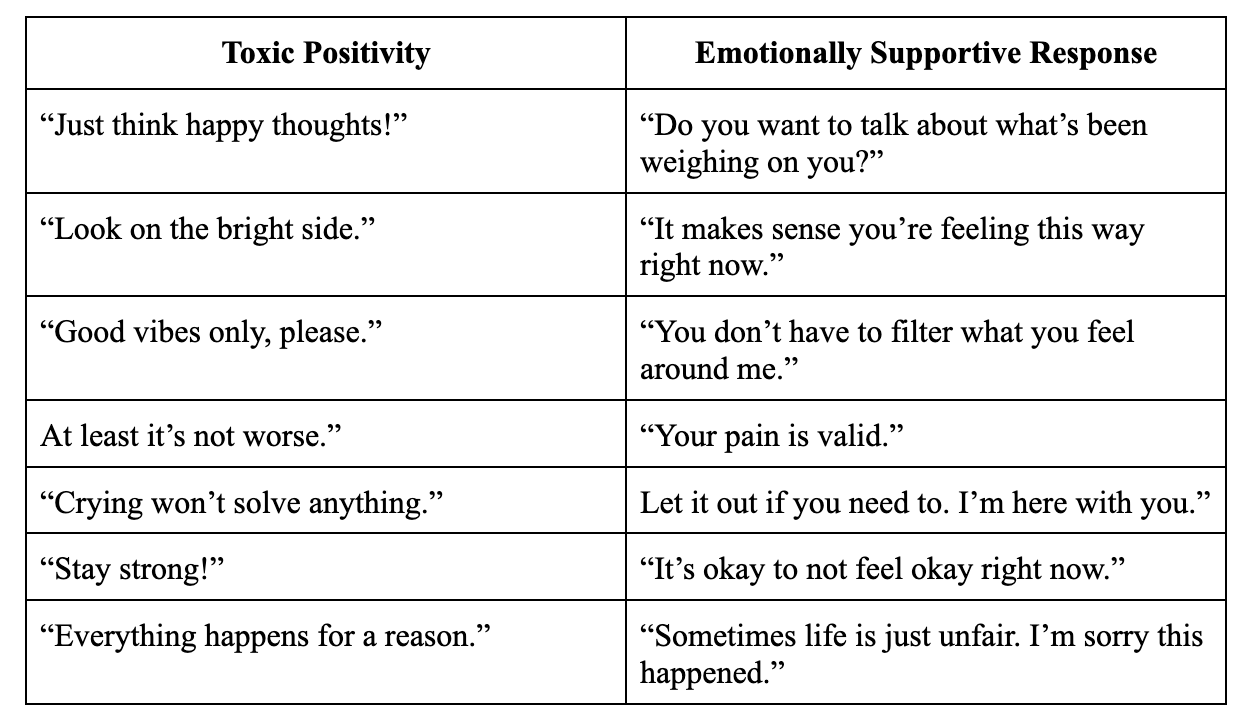“When life gives you lemons, make lemonade.”
We’ve all heard the phrase. It’s meant to be hopeful, to inspire optimism in the face of hardship. But what if you’re not ready to squeeze the lemons? What if the lemons are heavy, bruised, or just too many?
"Be positive."
"Good vibes only."
"Everything happens for a reason."
These phrases are everywhere - on Instagram captions, office posters, coffee mugs, and even well-meaning conversations with loved ones. They're meant to uplift, but often do the opposite. What they reflect is not resilience or encouragement, but toxic positivity.
What Is Toxic Positivity?
Toxic positivity refers to the cultural pressure to maintain a consistently positive mindset and suppress any form of negative emotion, regardless of its validity. It’s the overgeneralization of positive thinking to the point where it silences discomfort, grief, anger, pain, or any form of suffering.
This isn't a critique of positivity itself - hope and optimism are essential parts of mental well-being. But when positivity becomes performative, dismissive, or obligatory, it can become psychologically harmful.
The Cost of Forced Positivity
1. Emotion Suppression and Rebound Effects
One of the foundational studies in this area is by James Gross (2002), who developed the Process Model of Emotion Regulation.
His research shows that suppressing emotional expression - a key characteristic of toxic positivity - doesn't reduce the emotional experience itself. Instead, it increases physiological arousal, causes cognitive load, and diminishes emotional well-being over time. When people suppress their sadness or anxiety in favor of forced optimism, they may appear composed, but internally, the stress response remains active.
2. Invalidation and Psychological Safety
According to Carl Rogers, one of the fathers of humanistic psychology, unconditional positive regard - the acceptance of a person’s full range of emotions without judgment - is vital to psychological healing. Toxic positivity violates this core principle. It communicates, even subtly, that certain emotions are not acceptable or inconvenient.
This has significant consequences. When individuals do not feel safe expressing negative emotions, they lose access to psychological safety, a concept especially relevant in workplace mental health. Emotional invalidation can lead to shame, guilt, emotional disconnection, low self-worth, anxiety, depression, poor emotional regulation, strained relationships, among many others.
How Certain Cultures Reinforce Toxic Positivity
Psychologist Barbara Held (2001) coined the term "the tyranny of the positive attitude," critiquing the Western cultural obsession with relentless optimism. In individualistic societies that glorify success and personal control, acknowledging pain can be seen as weakness or failure.
Social media exacerbates this. Platforms curate lives filtered through highlight reels, often showcasing positivity as a personal achievement. “Grind culture,” “manifestation trends,” and the celebration of “resilience” without nuance all feed into the belief that we should be in control of our emotions at all times.
But mental health does not thrive on constant control. It thrives on emotional authenticity.
What Does Toxic Positivity Sound Like?
Here are some examples of toxic positivity and their emotionally validating alternatives:

The Cost of Constant Positivity
Forcing positivity can have real emotional and physiological consequences:
- Increased cortisol levels due to stress from suppression
- Impaired relationships due to emotional inauthenticity
- Internalized guilt or shame for experiencing “unacceptable” emotions
- Burnout and emotional exhaustion, especially in caregiving and high-stress roles
Studies like Daily Diary Longitudinal Study (Bastian, Pe, & Kuppens, 2017), Multi-National Study Across 40 Countries (Mauss et al. and colleagues, 2022), Value-Conflict Research on “Valuing Happiness” (Ford & Mauss, 2011–2014) show that people who feel pressured to present themselves as happy are more likely to experience depressive symptoms, particularly if they believe that showing sadness makes them a burden.
Balancing Optimism with Emotional Honesty
This is not to say that optimism or hope is wrong. In fact, Barbara Fredrickson’s Broaden-and-Build Theory (2001) shows that genuine positive emotions expand our cognitive and behavioral repertoire, building resilience over time. But the key word is genuine. Forced positivity doesn't build resilience - it breaks it.
True psychological well-being means:
- Making space for all emotions
- Processing feelings without judgment
- Allowing grief, anger, fear, and joy to coexist
- Creating environments (personal or professional) that welcome vulnerability
So What Can We Do Instead?
- Practice Emotional Validation
Acknowledge your own and others’ emotions without immediately trying to fix them. Sometimes just saying, “That makes sense. I’d feel the same way,” is enough.
- Normalize the Full Emotional Spectrum
Talk about sadness, burnout, and grief as naturally as we talk about excitement and joy.
- Choose Empathy Over Encouragement
When someone is struggling, what they often need is not motivation, but presence and space to process their emotions without judgement.
- Check Your Internal Dialogue
Are you policing your own feelings with statements like “I shouldn’t feel this way” or “I should be more grateful”? Try replacing them with: “This is how I feel right now, and that’s okay.”
- Allow Difficult Emotions to Exist
You don’t always have to turn pain into something pretty. Some moments aren’t meant to be productive. They’re meant to be felt.
Conclusion: Stay with the lemons, for the lemonade can wait.
Toxic positivity tells us we must always shine, always rise, always smile. But humans aren’t light switches. We’re layered, emotional, inconsistent, and beautifully complex. Some days are heavy. Some emotions hurt. And that’s not a failure, it’s part of being human. Not every experience needs to be reframed into a silver lining. Distress, sadness, and discomfort are not signs of failure, they are valid emotional responses to life’s complexity.
So maybe, the next time life gives you lemons, don’t rush to make lemonade.
Just sit with the lemons. Feel their weight. Acknowledge the sour.
And in those moments, it is not only acceptable, but profoundly human, to not be okay.


.png)
.jpg)



